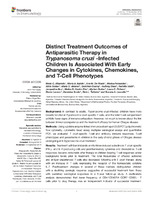Por favor, use este identificador para citar o enlazar este ítem:
http://sgc.anlis.gob.ar/handle/123456789/1414| Título : | Distinct Treatment Outcomes of Antiparasitic Therapy in Trypanosoma cruzi-Infected Children Is Associated With Early Changes in Cytokines, Chemokines, and T-Cell Phenotypes | Autor : | Albareda, María Cecilia Natale, María A De Rissio, Ana María Fernandez, Marisa Serjan, Alicia Alvarez, María G Cooley, Gretchen Shen, Huifeng Viotti, Rodolfo Bua, Jacqueline Castro Eiro, Melisa D Nuñez, Myriam Fichera, Laura E. Lococo, Bruno Scollo, Karenina Tarleton, Rick L Laucella, Susana A. |
Palabras clave : | Linfocitos T;Trypanosoma cruzi;benznidazole;Nifurtimox;infección pediátrica | Fecha de publicación : | 2018 | Journal: | Frontiers in immunology | Resumen : | Background: In contrast to adults, Trypanosoma cruzi-infected children have more broadly functional Trypanosoma cruzi-specific T cells, and the total T-cell compartment exhibits fewer signs of immune exhaustion. However, not much is known about the link between immunocompetence and the treatment efficacy for human Chagas disease. Methods: Using cytokine enzyme-linked immunosorbent spot (ELISPOT) polychromatic flow cytometry, cytometric bead assay, multiplex serological assays and quantitative PCR, we evaluated T. cruzi-specific T-cell and antibody immune responses, T-cell phenotypes and parasitemia in children in the early chronic phase of Chagas disease undergoing anti-Trypanosoma cruzi treatment. Results: Treatment with benznidazole or nifurtimox induced a decline in T. cruzi-specific IFN-γ- and IL-2-producing cells and proinflammatory cytokines and chemokines. T-cell responses became detectable after therapy in children bearing T-cell responses under background levels prior to treatment. The total frequencies of effector, activated and antigen-experienced T cells also decreased following anti-T. cruzi therapy, along with an increase in T cells expressing the receptor of the homeostatic cytokine IL-7. Posttreatment changes in several of these markers distinguished children with a declining serologic response suggestive of successful treatment from those with sustained serological responses in a 5-year follow-up study. A multivariate analysis demonstrated that lower frequency of CD4+CD45RA-CCR7-CD62L- T cells prior to drug therapy was an independent indicator of successful treatment. Conclusions: These findings further validate the usefulness of alternative metrics to monitor treatment outcomes. Distinct qualitative and quantitative characteristics of T cells prior to drug therapy may be linked to treatment efficacy. |
URI : | http://sgc.anlis.gob.ar/handle/123456789/1414 | DOI: | 10.3389/fimmu.2018.01958 |
| Aparece en las colecciones: | Publicaciones INP |
Ficheros en este ítem:
| Fichero | Descripción | Tamaño | Formato | |
|---|---|---|---|---|
| fimmu-09-01958.pdf | Artículo en inglés | 3.82 MB | Adobe PDF |  Visualizar/Abrir |
Visualizaciones de página(s)
143
comprobado en 16-dic-2025
Descarga(s)
28
comprobado en 16-dic-2025
Google ScholarTM
Consultar
Altmetric
Altmetric
Los ítems de DSpace están protegidos por copyright, con todos los derechos reservados, a menos que se indique lo contrario.

